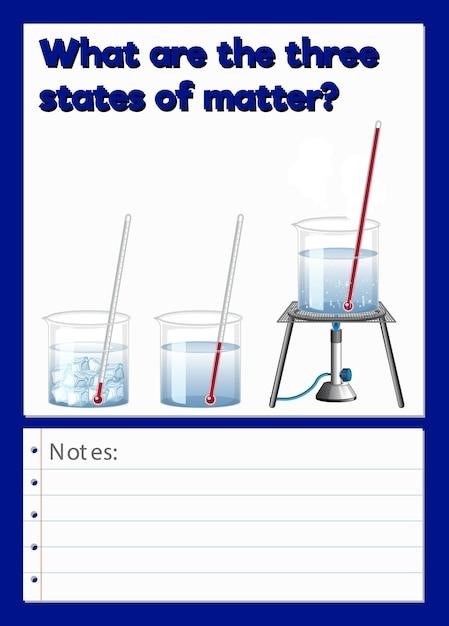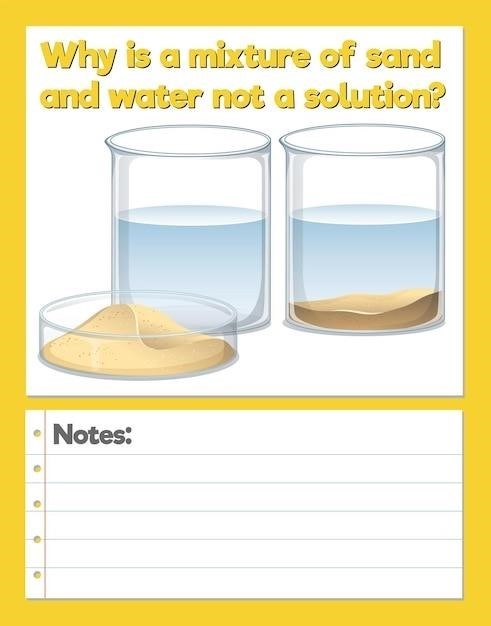Volume of a Cylinder Worksheets⁚ A Comprehensive Guide
This guide provides a collection of printable worksheets focusing on calculating the volume of cylinders. These resources include various difficulty levels, from basic problems to advanced exercises involving unit conversions. PDF versions with answers are available for convenient self-assessment.
Formulas and Key Concepts
The foundational formula for calculating the volume (V) of a cylinder is V = πr²h, where ‘r’ represents the radius of the circular base and ‘h’ denotes the height of the cylinder. Understanding this formula is paramount. Remember that the radius is half the diameter. The constant π (pi), approximately 3.14159, represents the ratio of a circle’s circumference to its diameter. Accurate measurement of ‘r’ and ‘h’ is crucial for precise volume calculations. Worksheets often present problems with varying units (centimeters, meters, yards, etc.), requiring careful attention to unit consistency throughout the calculation. Sometimes, the volume might be given, and you’ll need to solve for either the radius or height using algebraic manipulation of the formula. This involves isolating the unknown variable. For instance, to find the radius, rearrange the formula to r = √(V/(πh)). Similarly, to find the height, use h = V/(πr²). A strong grasp of these fundamental concepts and the ability to manipulate the formula are essential for successfully completing the provided worksheets and mastering cylinder volume calculations. Practice and attention to detail are key to accuracy.
Practice Worksheets⁚ Basic Problems
Begin your journey into cylinder volume calculations with our introductory worksheets. These exercises focus on straightforward problems, providing a solid foundation for understanding the core concept. Each problem presents a cylinder with clearly stated radius and height values, usually whole numbers to simplify calculations. The goal is to familiarize yourself with the formula (V = πr²h) and its application. These worksheets are designed to build confidence and reinforce the fundamental steps involved. Expect problems where you substitute the given radius and height directly into the formula and calculate the volume. This initial practice helps solidify your understanding before progressing to more complex scenarios. Pay close attention to the units of measurement (e.g., centimeters, meters) and ensure consistency in your calculations. The provided answer keys allow you to check your work and identify any areas needing further review. Mastering these basic exercises will provide a strong base for tackling more challenging problems in subsequent worksheets.
Practice Worksheets⁚ Intermediate Problems
Progress to our intermediate-level worksheets designed to challenge your understanding of cylinder volume calculations. These problems introduce slightly more complex scenarios, building upon the foundational knowledge gained from the basic exercises. Expect to encounter problems involving decimal values for radius and height, requiring more precise calculations and attention to detail. You might also find problems presenting the diameter instead of the radius, requiring an extra step to calculate the radius before applying the volume formula. Some problems may present the volume and one dimension (radius or height), requiring you to solve for the missing dimension. This step encourages a deeper understanding of the formula’s manipulation and algebraic skills. The use of π (pi) might be presented in its symbolic form or using approximations such as 3.14, offering opportunities to practice both exact and approximate calculations. Remember to maintain consistent units throughout your calculations and always double-check your work using the provided answer key to ensure accuracy and identify areas needing further attention. These exercises are crucial for developing proficiency and confidence before tackling advanced problems.
Practice Worksheets⁚ Advanced Problems (Including Unit Conversions)
This section presents advanced-level problems designed to comprehensively test your understanding of cylinder volume calculations. These worksheets incorporate unit conversions, demanding a deeper understanding of measurement systems and the ability to seamlessly convert between units such as centimeters, meters, inches, and feet. Problems may present dimensions in mixed units, requiring conversion before calculating the volume. This necessitates a strong grasp of conversion factors and the ability to apply them accurately within the volume formula. Expect to encounter more complex scenarios, such as multi-step problems involving multiple cylinders or those requiring the calculation of volume to solve real-world application problems. Some problems might involve calculating the volume of a cylinder given its surface area or other related properties, thereby promoting problem-solving skills and critical thinking. Remember to always clearly show your working, highlighting each step of the conversion process and the application of the volume formula. These advanced problems are designed to prepare you for more complex mathematical applications involving cylinders.

Resources for Volume of Cylinder Worksheets
This section offers access to free printable worksheets and PDF versions complete with answers, facilitating independent practice and self-assessment of cylinder volume calculations. Convenient online calculators are also linked.
Free Printable Worksheets
Access a wide array of free printable worksheets designed to enhance your understanding and skills in calculating the volume of cylinders. These worksheets cater to various skill levels, from foundational exercises suitable for middle school students to more challenging problems incorporating unit conversions and decimal values, ideal for high school learners. Each worksheet typically features multiple problems, allowing for ample practice and reinforcement of the formula V = πr²h. The problems are carefully structured to progress in difficulty, building confidence and competence. These readily available resources provide a flexible and convenient way to supplement classroom learning or independent study, allowing students to work at their own pace and focus on areas requiring extra attention. The clear and concise presentation of problems ensures that students can easily grasp the concepts and apply the formula effectively. Regular practice with these worksheets will undoubtedly improve problem-solving abilities and deepen understanding of cylinder volume calculations.
Worksheets with Answers (PDF Format)
Enhance your learning experience with our readily downloadable PDF worksheets, complete with comprehensive answer keys. These resources offer a convenient and efficient way to practice calculating the volume of cylinders. The inclusion of answers allows for immediate self-assessment, enabling students to identify areas where they excel and pinpoint concepts requiring further attention. This self-directed approach promotes independent learning and fosters a deeper understanding of the subject matter. The PDF format ensures easy accessibility and compatibility across various devices. Whether you are a student looking to bolster your skills, a teacher seeking supplementary materials, or a parent aiming to support your child’s education, these worksheets provide a valuable tool. The structured format and clear instructions make them user-friendly for all skill levels. The detailed solutions provided not only reveal the correct answers but also offer insights into the problem-solving process, aiding in comprehension and skill development.
Online Volume Calculators and Interactive Tools
Supplement your worksheet practice with dynamic online resources designed to enhance your understanding of cylinder volume calculations. Numerous websites offer free online volume calculators, allowing for quick verification of your answers and immediate feedback on your problem-solving approach. These tools are invaluable for checking your work and reinforcing your understanding of the formulas involved. Beyond simple calculators, interactive simulations and tutorials provide a visual and engaging learning experience. These interactive tools often allow you to manipulate the dimensions of a cylinder and observe the resulting changes in volume in real-time. This dynamic approach helps solidify your understanding of the relationship between a cylinder’s dimensions and its volume. Explore these resources to gain a deeper, more intuitive grasp of the concepts presented in your worksheets. The combination of hands-on practice with interactive digital tools creates a comprehensive and effective learning strategy.

Applications and Real-World Examples
Explore practical applications of cylinder volume calculations. From calculating the capacity of storage tanks to determining the amount of liquid in a cylindrical container, these worksheets bridge the gap between theory and practical scenarios.
Word Problems Involving Cylinders
This section delves into the practical application of cylinder volume calculations through a series of engaging word problems. These problems present real-world scenarios where understanding cylinder volume is crucial for problem-solving. For instance, students might be tasked with calculating the amount of water a cylindrical tank can hold, given its dimensions. Another example could involve determining the volume of grain stored in a cylindrical silo, requiring them to apply the formula V = πr²h and potentially perform unit conversions. The problems gradually increase in complexity, introducing challenges such as calculating the volume of partially filled cylinders or those with unusual shapes. These word problems encourage critical thinking and problem-solving skills by requiring students to interpret information, identify relevant formulas, and apply their mathematical knowledge to real-world contexts. By successfully tackling these word problems, students enhance their understanding of cylinder volume and its significance in various fields. The inclusion of answers allows for self-assessment and reinforcement of learned concepts. This approach ensures that students not only master the formula but also develop practical problem-solving abilities.
Using Volume Calculations in Different Fields
The ability to calculate the volume of cylinders extends far beyond the classroom, proving invaluable across numerous fields. In engineering, precise volume calculations are essential for designing pipelines, storage tanks, and other cylindrical structures. Architects utilize these calculations to determine the capacity of cylindrical components in buildings or to estimate material requirements. Manufacturing processes often rely on accurate volume measurements for efficient production and quality control, particularly in industries involving cylindrical containers or parts. The medical field uses volume calculations for tasks such as determining the appropriate dosage of medication delivered through cylindrical syringes or analyzing the capacity of cylindrical medical equipment. Even in everyday life, understanding cylinder volume can help in tasks like determining the amount of paint needed to cover a cylindrical column or calculating the storage capacity of a cylindrical container. The application of these skills underscores the practical relevance of mastering cylinder volume calculations, showcasing their utility in diverse professional and everyday scenarios.
Further Exploration of Cylinder Properties
Beyond calculating volume, a deeper understanding of cylinder properties opens doors to more complex mathematical and scientific concepts. Investigating the relationship between a cylinder’s volume, surface area, and its dimensions (radius and height) provides valuable insights into geometric principles and problem-solving strategies. Exploring the concept of similar cylinders and how scaling affects both volume and surface area strengthens proportional reasoning skills. Advanced studies might involve calculating the volume of truncated cylinders or cylinders with varying cross-sections, demanding a more nuanced understanding of integral calculus. Furthermore, delving into the applications of cylinder properties in physics, such as fluid dynamics or pressure calculations within cylindrical vessels, provides a practical context for theoretical concepts. Connecting the mathematical calculations to real-world scenarios enhances comprehension and cultivates a more holistic understanding of the properties of cylinders and their significance in various scientific and engineering disciplines. This deeper exploration fosters critical thinking and problem-solving skills applicable beyond the realm of geometry.